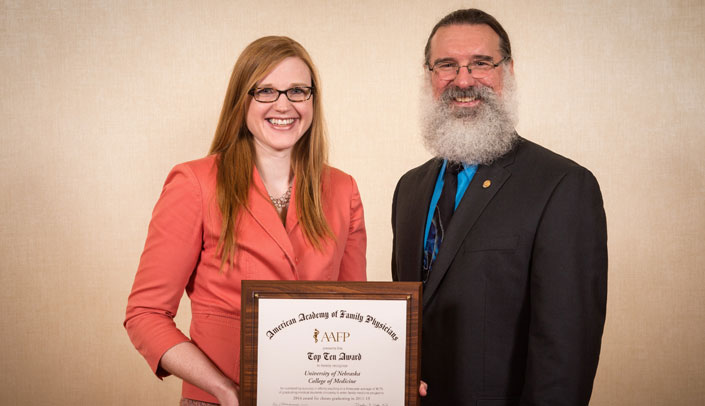The University of Nebraska Medical Center College of Medicine has been recognized by the American Academy of Family Physicians as one of the top 10 programs in the country in producing family physicians.
The award was presented at a conference of the Society of Teachers of Family Medicine in San Antonio.
Family physicians are qualified to treat most ailments and provide comprehensive health care for people of all ages — from newborns to seniors.
The award honors medical schools that — during a consecutive three-year period — graduated the greatest percentage of students who chose first-year family medicine residency positions.
The 2014 award recipients and the percentage of graduates entering family medicine were:
- University of North Dakota School of Medicine and Health Sciences — 23.3
- University of Kansas School of Medicine — 19.2
- Oregon Health & Science University School of Medicine — 19
- University of Missouri School of Medicine — 18.8
- Brody School of Medicine, East Carolina University — 18.6
- University of Minnesota Medical School — 18.0
- University of Washington School of Medicine — 17.6
- UNMC College of Medicine — 16.7
- University of Wisconsin School of Medicine and Public Health — 16.5
- Wright State University Boonshoft School of Medicine — 15.9
The percentages reflect students who graduated in 2011, 2012 and 2013 and matriculated into family medicine residency programs.
Awardees were recognized for employing a variety of initiatives that support students interested in becoming family physicians. These include:
- student outreach;
- faculty involvement in medical school committees;
- admissions policies that target students from rural and medically underserved areas;
- clinical rotations that emphasize positive experiences in family medicine;
- strong, student-run family medicine interest groups; and
- financial aid packages that minimize student debt.
“We are pleased to be honored by our peers. This award is a testament of the contributions by many at UNMC, by the full-time and volunteer faculty, the students who ultimately choose family medicine as a career and our health care partners across Nebraska,” said Michael Sitorius, M.D., chairman of the UNMC Department of Family Medicine. “The department has a long-standing commitment to training future family physicians and will continue its efforts to increase the family medicine workforce for all of Nebraska.”
At a time when the United States is facing a shortage of primary care physicians, filling the family physician workforce pipeline is vital to the health of Americans, AAFP President Reid Blackwelder, M.D., said.
“For the past five years, we have seen growth in student interest in family medicine,” Dr. Blackwelder said. “Much of the credit for that increase goes to the medical schools that have actively supported family medicine as the comprehensive, challenging and professionally fulfilling specialty that it is.
“These 10 schools have demonstrated their consistent commitment to meeting the nation’s need for family physicians, and I commend them, their leadership and their faculty for helping ensure that Americans have access to the care they need.”
The importance of family physicians also has escalated as the complexity of primary care has intensified.
In addition to providing preventive and first-encounter care, family physicians diagnose and treat patients with conditions ranging from a sore throat to multiple, complex conditions such as diabetes combined with congestive heart failure.
Research has shown family physicians are the usual source of care for more than six in 10 patients with anxiety, depression or diabetes; six in 10 patients with cancer, and nearly six in 10 patients with heart disease.
Most recently, authors of “Patients with High Cost Chronic Conditions Rely Heavily on Primary Care Physicians” in the January-February issue of the Journal of the American Board of Family Medicine reported 86 percent of visits for asthma occurred in primary care physician offices, compared to 14 percent in subspecialist offices, and 84 percent of visits for chronic obstructive pulmonary disease were in primary care physician offices, compared to 15 percent in subspecialist offices.
